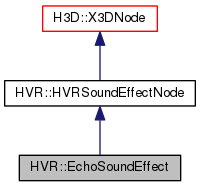|
Candy
|
|
Candy
|
The echo effect generates discrete, delayed instances of the input signal. More...

Classes | |
| struct | Updater |
Public Member Functions | |
| EchoSoundEffect (H3D::Inst< H3D::SFNode > _metadata=0, H3D::Inst< Updater > _updater=0, H3D::Inst< H3D::SFFloat > _delay=0, H3D::Inst< H3D::SFFloat > _lrDelay=0, H3D::Inst< H3D::SFFloat > _damping=0, H3D::Inst< H3D::SFFloat > _feedback=0, H3D::Inst< H3D::SFFloat > _spread=0) | |
 Public Member Functions inherited from HVR::HVRSoundEffectNode Public Member Functions inherited from HVR::HVRSoundEffectNode | |
| HVRSoundEffectNode (H3D::Inst< H3D::SFNode > _metadata=0, H3D::Inst< SFSoundFilter > _soundFilter=0) | |
| virtual std::string | defaultXMLContainerField () |
| void | addSource (ALuint source_id) |
| Add an OpenAL source id to use this effect. More... | |
| void | removeSource (ALuint source_id) |
| Remove a previously added OpenAL source id from this effect. More... | |
Public Attributes | |
| std::auto_ptr< H3D::SFFloat > | delay |
 (0.0–0.207) (0.1) This property controls the delay between the original sound and the first ‘tap’, or echo instance. More... (0.0–0.207) (0.1) This property controls the delay between the original sound and the first ‘tap’, or echo instance. More... | |
| std::auto_ptr< H3D::SFFloat > | lrDelay |
 (0.0–0.404) (0.1) This property controls the delay between the first ‘tap’ and the second ‘tap’. More... (0.0–0.404) (0.1) This property controls the delay between the first ‘tap’ and the second ‘tap’. More... | |
| std::auto_ptr< H3D::SFFloat > | damping |
 (0.0–0.99) (0.5) This property controls the amount of high frequency damping applied to each echo. More... (0.0–0.99) (0.5) This property controls the amount of high frequency damping applied to each echo. More... | |
| std::auto_ptr< H3D::SFFloat > | feedback |
 (0.0–1.0) (0.5) This property controls the amount of feedback the output signal fed back into the input. More... (0.0–1.0) (0.5) This property controls the amount of feedback the output signal fed back into the input. More... | |
| std::auto_ptr< H3D::SFFloat > | spread |
 (-1.0–1.0) (-1.0) This property controls how hard panned the individual echoes are. More... (-1.0–1.0) (-1.0) This property controls how hard panned the individual echoes are. More... | |
 Public Attributes inherited from HVR::HVRSoundEffectNode Public Attributes inherited from HVR::HVRSoundEffectNode | |
| std::auto_ptr< SFSoundFilter > | soundFilter |
 (Null) This is a HVRSoundFilterNode that, if set, will filter the sound played through this effect node. More... (Null) This is a HVRSoundFilterNode that, if set, will filter the sound played through this effect node. More... | |
Static Public Attributes | |
| static H3D::H3DNodeDatabase | database |
 Static Public Attributes inherited from HVR::HVRSoundEffectNode Static Public Attributes inherited from HVR::HVRSoundEffectNode | |
| static H3D::H3DNodeDatabase | database |
Protected Member Functions | |
| void | updateParameters (float delay, float lrDelay, float damping, float feedback, float spread) |
 Protected Member Functions inherited from HVR::HVRSoundEffectNode Protected Member Functions inherited from HVR::HVRSoundEffectNode | |
| void | pushParameterChanges () |
Protected Attributes | |
| struct HVR_API | Updater |
| std::auto_ptr< Updater > | updater |
 Protected Attributes inherited from HVR::HVRSoundEffectNode Protected Attributes inherited from HVR::HVRSoundEffectNode | |
| std::map< ALuint, ALuint > | effectslot_per_source |
| Associated OpenAL identifiers. More... | |
| ALuint | effect_id |
| Associated OpenAL effect identifier. More... | |
The echo effect generates discrete, delayed instances of the input signal.
The amount of delay and feedback is controllable. The delay is ‘two tap’ – you can control the interaction between two separate instances of echoes.
This node is a part of a sound node structure based on the OpenAL/EFX standards. It supports sound spatialization, sound effects and filtering.
| std::auto_ptr<H3D::SFFloat> HVR::EchoSoundEffect::damping |
 (0.0–0.99) (0.5) This property controls the amount of high frequency damping applied to each echo.
(0.0–0.99) (0.5) This property controls the amount of high frequency damping applied to each echo.
As the sound is subsequently fed back for further echoes, damping results in an echo which progressively gets softer in tone as well as intensity.
| std::auto_ptr<H3D::SFFloat> HVR::EchoSoundEffect::delay |
 (0.0–0.207) (0.1) This property controls the delay between the original sound and the first ‘tap’, or echo instance.
(0.0–0.207) (0.1) This property controls the delay between the original sound and the first ‘tap’, or echo instance.
Subsequently, the value for Echo Delay is used to determine the time delay between each ‘second tap’ and the next ‘first tap’.
| std::auto_ptr<H3D::SFFloat> HVR::EchoSoundEffect::feedback |
 (0.0–1.0) (0.5) This property controls the amount of feedback the output signal fed back into the input.
(0.0–1.0) (0.5) This property controls the amount of feedback the output signal fed back into the input.
Use this parameter to create “cascading” echoes. At full magnitude, the identical sample will repeat endlessly. Below full magnitude, the sample will repeat and fade.
| std::auto_ptr<H3D::SFFloat> HVR::EchoSoundEffect::lrDelay |
 (0.0–0.404) (0.1) This property controls the delay between the first ‘tap’ and the second ‘tap’.
(0.0–0.404) (0.1) This property controls the delay between the first ‘tap’ and the second ‘tap’.
Subsequently, the value for Echo LR Delay is used to determine the time delay between each ‘first tap’ and the next ‘second tap’.
| std::auto_ptr<H3D::SFFloat> HVR::EchoSoundEffect::spread |
 (-1.0–1.0) (-1.0) This property controls how hard panned the individual echoes are.
(-1.0–1.0) (-1.0) This property controls how hard panned the individual echoes are.
With a value of 1.0, the first ‘tap’ will be panned hard left, and the second tap hard right. A value of -1.0 gives the opposite result. Settings nearer to 0.0 result in less emphasized panning.
 1.8.6
1.8.6